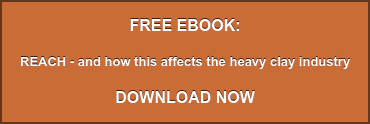
Registration, Evaluation, Authorisation & restriction of CHemicals (REACH) is a regulation that aims to make the handling and commercialisation of chemicals safer. In this blog article we talk about how this regulation affects heavy clay manufacturing in particular.
A brief history leading to the Directive
Dangerous Substances Directive - 67/548/EEC - concerning chemical safety- came in to force 29th June 1967 and implementation 1st January 1970 giving the approximation of laws, regulations and administrative provisions relating to the classification, packaging and labelling of dangerous substances.
Dangerous Preparations Directive 1999/45/EC - concerning the field of occupational safety and health and consumer protection- came in to force 30th July 1999 and implementation 30th July 2002 giving the approximation of the laws, regulations and administrative provisions of the Member States relating to the classification, packaging and labelling of dangerous preparations.
These two directives became harmonized via Chemicals (Hazard Information and Packaging for Supply) CHIP from 1994 onwards.
Regulation (EC) No 1907/2006 of 18 December 2006 concerning the Registration, Evaluation, Authorisation and Restriction of Chemicals (REACH), establishing a European Chemicals Agency which became law from 1st June 2007. CHIP was revoked On 1st June 2015 and replaced by European Regulation (EC) No 1272/2008 on classification, labelling and packaging of substances and mixtures which came into force on 20 January 2009 in all EU Member States. It is known by its abbreviated form, ‘the CLP Regulation’ or just plain ‘CLP’.
The CLP regulation has been continually updated with changes to the Appendices and the most current version is now EU 2017/1510 in which the EU Commission places over 20 carcinogenic, mutagenic, or reprotoxic – CMR - substances on Annex XVII list of restricted substances under REACH.
The transition phase
To assist chemical suppliers in managing the change from the old directives system (CHIP) to CLP a lengthy two-phase transitional period was applied. The first phase covered substances and ran until 30 November 2012. Since 1 December 2012, the CLP Regulation has applied in full to substances placed on the market. The second phase covered mixtures (formerly preparations) and ran until 31 May 2015. From 1 June 2015, the CLP Regulation applies in full to mixtures that are placed on the market.
There are certain limited circumstances where the transitional arrangements for mixtures can be extended. Where a mixture (formerly a preparation) has already been classified, labelled and packaged according to CHIP, and placed on the market before 1 June 2015, it did not have to be recalled for re-labelling and re-packaging. This derogation was available until 1 June 2017 and now all mixtures placed on the market must comply with the CLP Regulation.
What is the purpose of CLP?
- Adopts in the EU the Globally Harmonised System (GHS) on the classification and labelling of chemicals thus ensuring the same classifications and labelling will be used throughout the world.
- Applies directly in all EU member states which means that no national legislation is needed
- Is overseen by the European Chemicals Agency (ECHA)
The principles behind how REACH works
REACH aims to fill a gap in what we know about the chemicals used every day in industry and in consumer products. It takes a broad view of chemical use, and places new duties on businesses depending on where they sit in the supply chain.
One of the main new systems set up by REACH is ‘Registration’. Companies who manufacture chemical substances or import them into Europe – either on their own or mixed together to make chemical products - are at the top of the European supply chain. These companies have to ‘register’ a dossier of technical information about each substance they manufacture or import above a tonne a year with the ECHA. Once registered they will be given a unique number which all suppliers or importers of that product will use:
- 01-211 9489 177-25-xxxx
- 01-211-9502-547-42-xxxx
- 01-211-9494-219-28-xxxx
- 01-211-9452-801-43-xxxx
- 01-211-9456-624-35-xxxx
- 01-211-9457-892-27-xxxx
REACH should result in more information being passed down the supply chain to users – for example safety data sheets will give more information about the exposure scenarios and risk management measures that should be taken when using a product – as will be seen later
What are the benefits of REACH
This Regulation should ensure a high level of protection of human health and the environment as well as the free movement of substances, on their own, in mixtures and in articles, while enhancing competitiveness and innovation. This Regulation should also promote the development of alternative methods for the assessment of hazards of substances.
It should preserve the integrity of the internal market and ensure a high level of protection for human health, especially the health of workers, and the environment, it is necessary to ensure that manufacturing of substances in the Community complies with Community law, even if those substances are exported.
It will also ensure workability and maintain the incentives for waste recycling and recovery, wastes should not be regarded as substances, mixtures or articles within the meaning of this Regulation.
This Regulation is based on the principle that it is for manufacturers, importers and downstream users to ensure that they manufacture, place on the market or use such substances that do not adversely affect human health or the environment.
An important benefit established by this Regulation is to continually ensure that substances of very high concern are either taken out of use altogether, specifically authorised for use or replaced by less dangerous substances or technologies where suitable economically and technically viable alternatives are available. The current list of these SVHC can be found in the REACH website and it currently contains 174 substances, Annex XIV Authorisation List has 43 current substances and Annex XVII restricted substances has 65 current products.
This Regulation does not affect the European Community Directive 89/391/EC on worker protection and the environment - including Directive 2004/37/EC on the protection of workers from the risks related to exposure to carcinogens or mutagens at work and Council Directive 98/24/EC on the protection of the health and safety of workers from the risks related to chemical agents at work - under which employers are required to eliminate dangerous substances, wherever technically possible, or to substitute dangerous substances with less dangerous substances.
Do you want to know all about REACH? Download our ebook!





